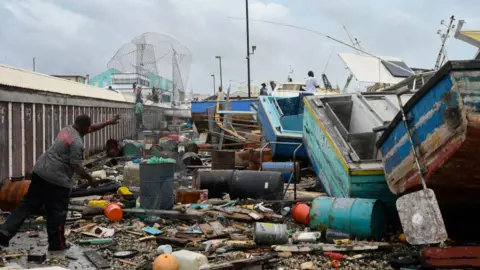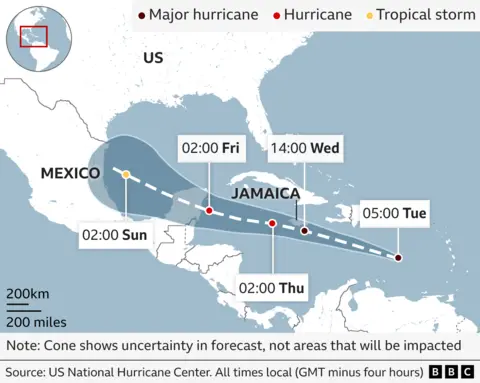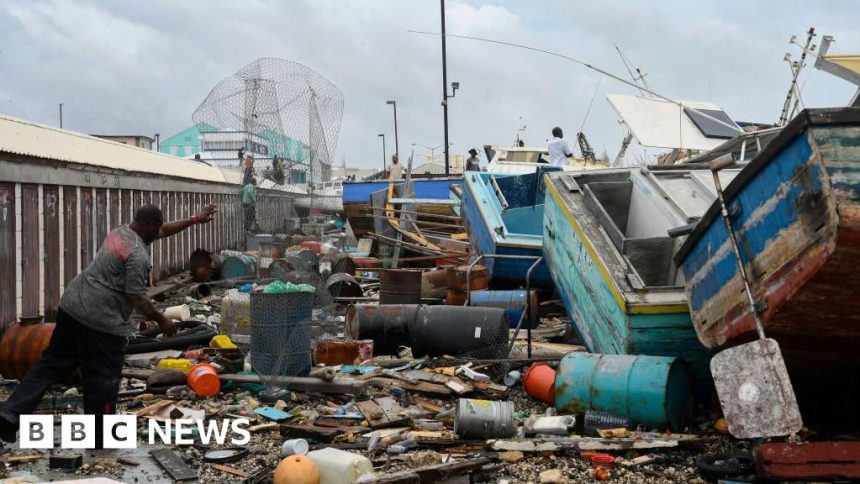‘Potentially catastrophic’ Hurricane Beryl moves towards Jamaica
 Getty Images
Getty ImagesA deadly hurricane which has been tearing through the Caribbean is intensifying as it moves towards Jamaica.
Hurricane Beryl is now a category five storm, meaning its winds and storm surges could prove catastrophic.
The storm made landfall on Monday on Carriacou, an island which is part of Grenada.
So far, there are reports of two people dead as a result of the storm, one in Grenada and one in St Vincent.
Beryl hit land on Monday as a category four hurricane, with sustained winds of 150mph (240km/h).
The US National Hurricane Center (NHC) said Carriacou had taken a direct hit from Hurricane Beryl’s “extremely dangerous eyewall” – a ring of thunderstorms which produces heavy rain and particularly strong winds.
Communications with Carriacou and the nearby island of Petite Martinique are still disrupted.
The Prime Minister of Grenada, Dickon Mitchell, warned that there could be more fatalities than the one reported in Grenada so far.
Mr Mitchell said the true extent of the damage would not be known until officials were able to reach the islands.
Mikey Hutchinson, a journalist in Grenada, told the BBC’s Newsday programme that at the height of the storm the situation had been “really, really bad”.
“It was extensive in terms of the strength of the wind and the intensity of the rain. We had a lot of reports of damage to homes, houses, a few government buildings,” he said.
St Vincent and the Grenadines, to the north-east of Grenada, was also devastated by Hurricane Beryl.
Its Prime Minister, Ralph Gonsalves, said that at least one person had been killed by the storm.
He said that Storm Beryl had “left in its wake immense destruction”.
According to the prime minister, the situation on Union Island – a small island with around 3,000 inhabitants – was particularly dire.
“The reports that I have received indicate that 90% of the houses have been severely damaged or destroyed,” he said.
Mr Gonsalves also warned that “there may well be more fatalities, we are not yet sure”.
Thousands of people are still without power and many are in temporary shelters in St Vincent and the Grenadines, Grenada and St Lucia.
Footage shared on social media showed homes with their roofs blown off and residents picking through rubble to salvage their possessions.
Barbados, which had issued a hurricane warning as Storm Beryl approached, seems to have been spared major damage.
A government official said that while the country had “dodged a bullet”, people should not let down their guard as “gusts are still coming, the storm-force winds are still coming”.
Predicted path of Hurricane Beryl

Meteorologists from the National Hurricane Center say Beryl continues to strengthen as it moves through the south-eastern Caribbean.
The NHC warns Beryl is expected bring “life-threatening winds and storm surge to Jamaica later this week”, most likely on Wednesday afternoon local time.
The Jamaican government has issued a hurricane warning and people living in low-lying and flood-prone areas have been urged to seek shelter.
A waiter in Kingston told Reuters news agency that the atmosphere in the Jamaican capital was calm.
“Jamaicans wait until the last minute. The night before or in the morning, the panic sets in. It’s because we’re used to this,” he said.
But the mayor of the resort town of Montego Bay warned residents not to take a “wait and see” attitude and urged them to be “prepared for anything”.
Before reaching Jamaica, Hurricane Beryl could also cause damage in Haiti and the Dominican Republic, which share the island of Hispaniola.
Haiti, which has in the past been devastated by earthquakes and whose interim government is trying to wrest control of the capital from powerful gangs, is particularly poorly prepared for the devastation Beryl could cause.
Guy Vital-Herne from the charity World Vision told the BBC that “as of right now, Haiti is definitely not ready for something like that”.
“In the past, we’ve seen rains causing roads to flood, diminishing logistical capacities and even collapsing bridges. So it would be very catastrophic for Haiti to be highly impacted by Beryl right now.”
 Reuters
ReutersThe NHC said that Hurricane Beryl was the earliest category five storm in the Atlantic they had ever recorded, forming much earlier in the hurricane season than usual.
Meteorologists have also remarked on how quickly Beryl developed.
The storm strengthened from a tropical depression into a major hurricane – category three or above – in only 42 hours, hurricane expert Sam Lillo told Associated Press news agency.
The US National Oceanic and Atmospheric Administration (NOAA) has warned that the North Atlantic could get as many as seven major hurricanes this year – up from an average of three in a season.








